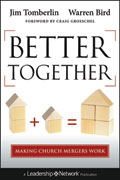
By Rez Gopez-Sindac
Making the case for church mergers as a viable option for impact and revitalization.
Roughly 80 percent of the 300,000 Protestant churches in the United States have plateaued or are declining, and many of them are in desperate need of a vibrant ministry. Among the 20 percent of growing congregations across the United States, many are in desperate need of space.
These conditions, according to Jim Tomberlin and Warren Bird, authors of Better Together: Making Church Mergers Work (Jossey-Bass, 2012), present a potential win-win for forward-thinking church leaders who believe that “we can do better together than separate.”
Tomberlin, who lives in Scottsdale, AZ, is an expert in developing and implementing customized multisite strategies for churches. Bird, on the other hand, resides in Suffern, NY, and is the intellectual capital director for Leadership Network. The book, probably the first to deal with church mergers, offers specific, practical advice on best practices in the merger process. The authors claim that mergers have tremendous potential to exponentially expand the impact of strong, vibrant churches as well as revitalize plateaued and declining churches. They note, however, that mergers are not for the faint of heart.
Challenges to overcome
“All mergers are messy and complicated, with no guarantees,” says Tomberlin, speaking for both authors. “Mergers are hard work and require honest assessment of your church and your motives for ministry, even if painful to acknowledge.”
One of the biggest issues is the refusal of the senior pastor, senior lay leaders or influential members of the joining church to release control. Tomberlin says most struggling churches would rather hold onto the steering wheel of their sinking ship than turn the helm over to an effective leader who knows how to sail the ship.
Another challenge is addressing the pain that the smaller or weaker church feels in a merger. “There is no gain without pain,” Tomberlin says. “Struggling churches will not change until the pain of not changing is greater than the pain of changing.” What the “weaker” church needs to see, Tomberlin adds, is its story as continuing through a new expression, much like a family relocating to join a larger clan. Each family unit is needed, he adds, but the clan does not look the same as any one family that joined it.
Humility is key
It takes humility to make a merger work. Churches that are stuck or in decline need humility to acknowledge they are struggling and need a new start, according to Tomberlin. Likewise, he adds, lead churches need to have humility about their role in shepherding new people toward a new vision and not coming in as though they have the answer to every problem.
Mergers could also look like a takeover. But when trust is earned and faith extended, Tomberlin says the merging of churches becomes more like a delicate dance in which one leads and the other follows. Some churches are almost equal in size and health, he adds, but regardless, one always leads and the other follows.
The best merger scenario, Tomberlin points out, is when the joining church follows the lead church enthusiastically. But if the relationship is not seen as mutually beneficial, the two churches should walk away from the merger conversation, suggests Tomberlin.
“It is easier to do nothing to avoid potential conflict than to try to reforge two cultures together under one new identity,” Tomberlin says. “It may be ‘easier’ not to merge in the short range, but in the long range successful mergers have a potential for greater gain.”
Mergers are built on trust and faith, and more likely to succeed when there is collaboration in areas of common interest. Tomberlin says trust is earned by demonstrating genuine love and concern for the joining congregation, not just their facilities, assets or increased attendance. He adds that faith is extended by the joining congregation when they believe the lead church is trustworthy.
“Mergers have to be approached as two teams humbly uniting around the same vision,” says Tomberlin.
_______________________________________________________________
Four merger types — well, three really
Rebirth — a struggling or dying church that gets a second life or restart by joining a stronger, vibrant and typically larger church.
Adoption — a stable or stuck church that is integrated under the vision of a stronger, vibrant and typically larger church.
Marriage — two churches, both strong and growing although often at different life stages, that realign with each other under a united vision and new leadership configuration.
ICU — two struggling or dying churches that join together in an effort to survive. This is the only model that we do not recommend, but historically it’s been the most widespread model, and it usually fails. — JT
_______________________________________________________________
Merge to serve better
 One percent of the Protestant churches in your community are going to close this year. Could those churches be redeemed or revitalized through a merger with your church? Approach those churches with humility and a kingdom of God mindset about their situation and propose the possibility. Meanwhile, serve your community together with other churches. Build bridges of trust with other local church:
One percent of the Protestant churches in your community are going to close this year. Could those churches be redeemed or revitalized through a merger with your church? Approach those churches with humility and a kingdom of God mindset about their situation and propose the possibility. Meanwhile, serve your community together with other churches. Build bridges of trust with other local church:
Connect: Take the initiative to get acquainted. You share a common geography; why not share friendship
over coffee?
Resource: Share information, materials and training freely. Make your expertise available. Develop coaching or mentoring opportunities.
Partnership: Collaborate together in areas of common interest and for the common good of the community. The community will be better served, local
churches will be strengthened, and the kingdom of God will be extended. Mergers are more likely to grow out of that soil. — JT


